The overall fisheries production in Region I declined by 5.8 percent in 3rd quarter 2018. From the total output of 24,800 metric tons a year ago, it went down to 23,365 metric tons this year. The provinces of Ilocos Sur and Pangasinan posted decrements in output.
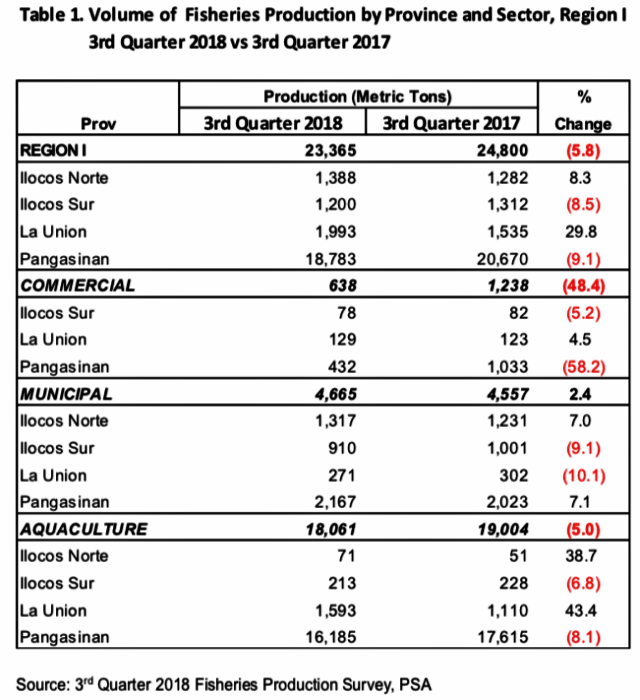
The commercial and aquaculture subsectors registered lower growths. The aquaculture contributed 77.3 percent to the total fisheries output. The municipal and commercial fisheries accounted 20.0 percent and 2.7 percent, respectively.
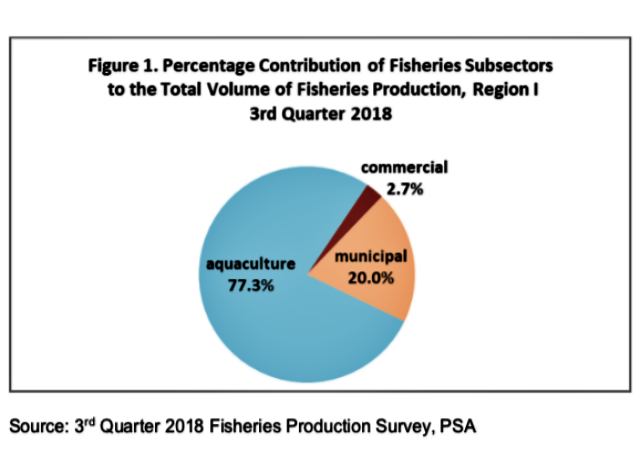
In terms of provincial distribution, the province of Pangasinan shared the bulk of production of about 80.4 percent. The overall volume of production of the province was posted at 18,783 metric tons, or 9.1 percent lower than its production in the same period of 2017. The production of its aquaculture and commercial subsectors declined by 8.1 percent, and 58.2 percent, respectively. Meanwhile, the municipal subsector grew by 7.1 percent.
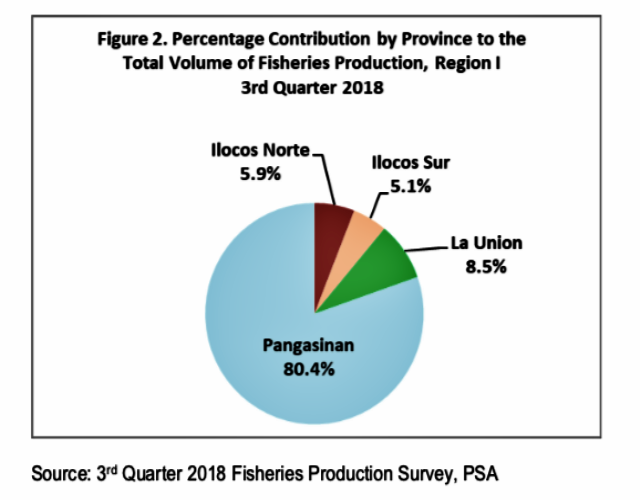
The province of La Union registered higher fisheries production in 3rd quarter 2018 as compared with the level a year ago. From 1,535 metric ton production last year, it went up to 1,993 metric tons this year. The increment in the output of the commercial and aquaculture sub-sectors contributed to the overall growth. The fisheries production of Ilocos Norte grew by 8.3 percent in 3rd quarter 2018. Its output was posted at 1,388 metric tons, higher than the output of 1,282 metric tons a year ago. Both the municipal and aquaculture subsectors registered positive growths.
The fisheries production of Ilocos Sur registered negative growth in 3rd quarter 2018. Its output was recorded at 1,200 metric tons, or 8.5 percent lower than the production in 3rd quarter 2017 of 1,312 metric tons. All the three sub-sectors displayed downward trends.
Commercial Fisheries
The commercial fisheries volume of production in Region I went down by 48.4 percent in 3rd quarter 2018. Its output was posted at 638 metric tons, lower than the output in the same period in 2017 of 1,238 metric tons. The provinces of Ilocos Sur and Pangasinan posted lower production. Lesser fishing days due to rough seas brought by long period of habagat, and lesser number of fishing vessels were the factors that contributed to the overall decline in output.
In terms of provincial shares, Pangasinan accounted for 67.6 percent of the region’scommercial fisheries volume of production in 3rd quarter 2018. It was followed by La Union with 20.2 percent share and Ilocos Sur with 12.2 percent share.
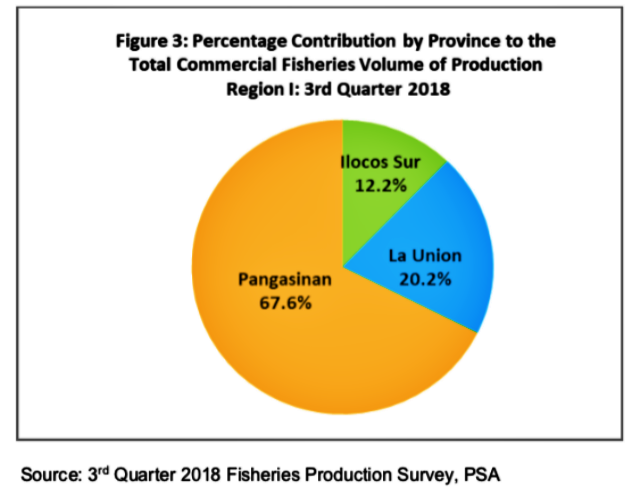
The top five major catch in the region during the 3rd quarter 2018 were Roundscad, Skipjack, Threadfin bream, Indo-pacific mackerel, and Big-eyed scad.

Municipal Fisheries
The overall municipal fisheries production of Region I grew in 3rd quarter 2018. The production was posted at 4,665 metric tons, higher than the output in 3rd quarter 2017 of 4,557 metric tons. The increased catch in the marine municipal fisheries contributed to the overall positive performance of the sub-sector.
Marine Municipal
Production of Marine Municipal Fisheries in Region I in 3rd quarter 2018 was posted at 4,276 metric tons, higher than the output in the same quarter of 2017 of 4,118 metric tons. The provinces of Ilocos Norte and Pangasinan contributed to the overall increment in output. More harvests from artificial reefs, presence of school of fish with bigger sizes, and increased fishing days were the factors that may contributed to the positive growth.
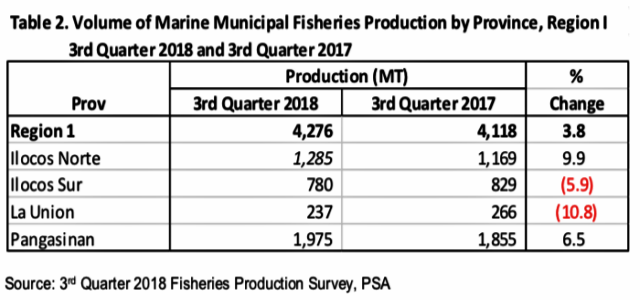
The province of Pangasinan contributed 46.2 percent to the region’s marine municipalfish catch for the 3rd quarter 2018, followed by Ilocos Norte with 30.0 percent share, Ilocos Sur with 18.2 percent share, and La Union with 5.5 percent. The dominant catch in marine municipal waters of Region I during the period were Rounscad, Yellowfin tuna, Cavalla, Skipjack and Siganid.
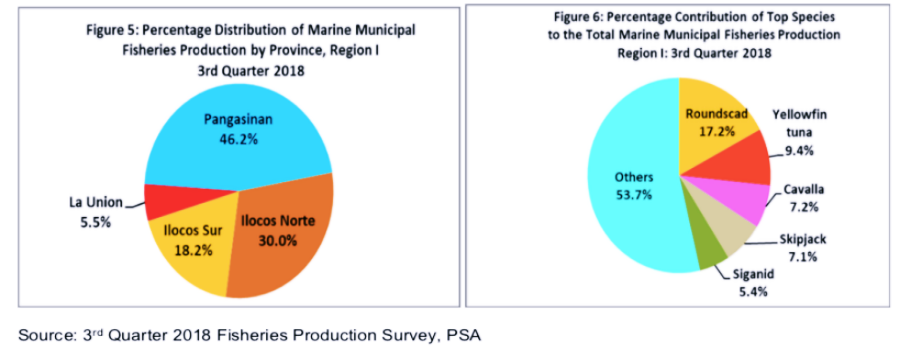
Inland Municipal Fisheries
Production of Inland Municipal Fisheries in Region I went down by 11.4 percent in 3rdquarter 2018. From its output of 439 metric tons in the same period last year, it went down to 389 metric tons this year. All the provinces, except Pangasinan, posted lower output. Lesser fishing days attributed to strong water current and turbid water caused by habagat and Typhoon Ompong resulted to lower catch. Also, some fish shelters were flooded, and catch were of smaller in sizes.
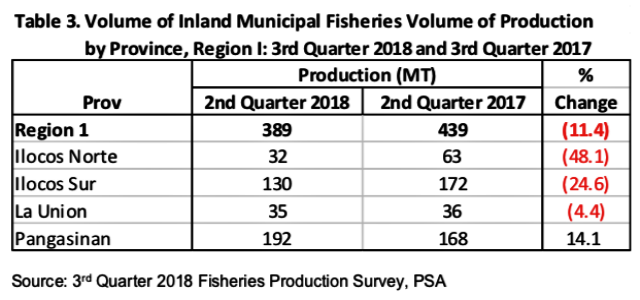
By province, Pangasinan ranked first in the volume of production of Inland municipal fisheries during the 3rd quarter 2018 with 49.4 percent share. Ilocos Sur followed with 33.4 percent share, La Union with 8.9 percent, and Ilocos Norte with 8.3 percent. The top five major catch in the region during the period were Tilapia, Freshwater goby, Endeavor prawn, Freshwater crab, and Mudfish.
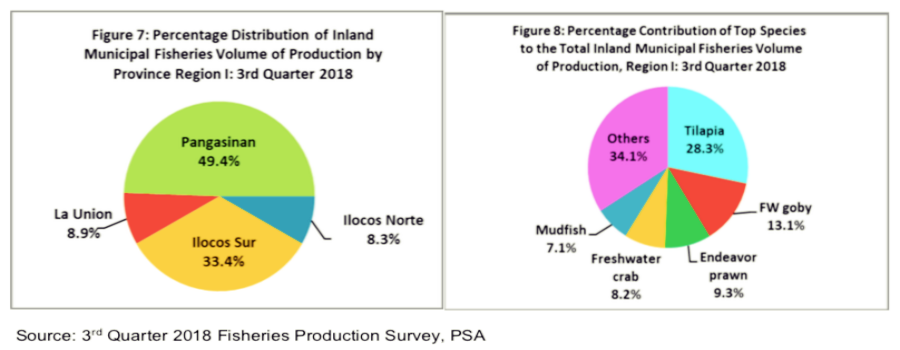
Aquaculture
Aquaculture production of Region I posted a production of 18,061 metric tons in 3rd quarter 2018. It is lower than the output in the same period in 2017 of 19,004 metric tons as some were damaged during the occurrence of Typhoon Ompong and long period of habagat. Lower survival rate and smaller sizes of catch were also observed. Almost all ecosystems registered negative growth in output. The provinces of Pangasinan and Ilocos Sur recorded lower production. The province of Pangasinan shared the bulk of aquaculture production during the period with 89.6 percent. By culture type, aquaculture in Region I was dominated by Marine cage which accounted for 53.7 percent of the total production.
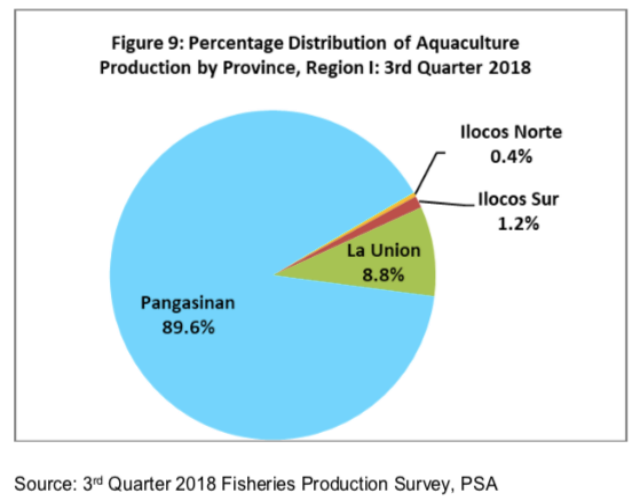
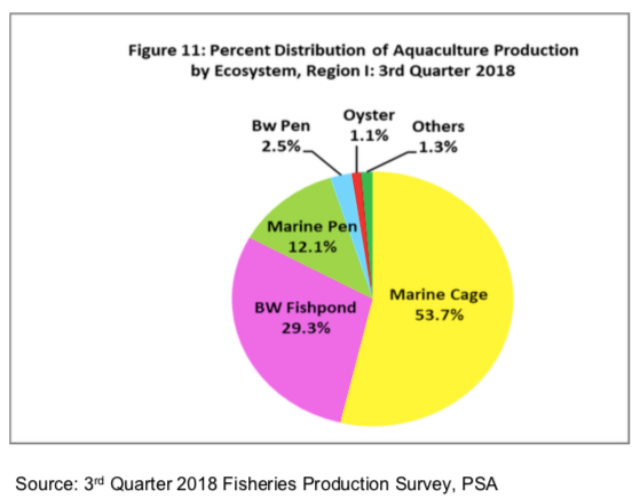
Milkfish dominated the aquaculture production of Region I with a share of 94.8 percent. Its production in 3rd quarter 2018 was posted at 17,121 metric tons, lower than its output in the same quarter last year of 17,744 metric tons. Some stocks were lost due to flooding caused by habagat and Typhoon Ompong. Lower survivability and smaller sizes of catch was also observed.
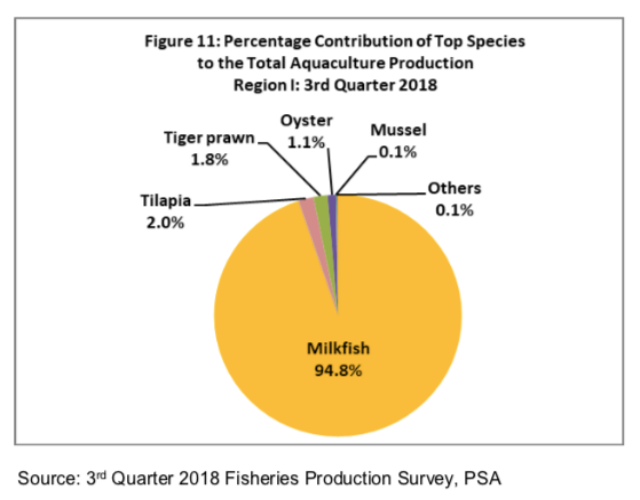
TECHNICAL NOTES
-
The Fisheries Production Survey of the Philippine Statistics Authority (PSA) is divided into four (4) major fisheries surveys. These are the Quarterly Commercial Fisheries Survey (QCFS), Quarterly Municipal Fisheries Survey (QMFS), Quarterly Inland Fisheries Survey (QIFS) and Quarterly Aquaculture Survey (QAqS). The commercial and municipal fisheries surveys aim to provide quarterly data on volume and value of fish production by species, by region, and by province. The aquaculture survey is intended to generate quarterly data on volume and value of cultured species by environment, by type of aquafarm, by region, and by province.
-
Concepts and Definitions:
Aquaculture – fishery operation involving all forms of raising and culturing of fish and other fishery species in marine, brackish and freshwater environment. Examples are fishponds, fish pens, fish cages, mussel, oyster, seaweed farms and hatcheries.
Aquafarm – the farming facilities used in the culture or propagation of aquatic species including fish, mollusk, crustaceans, and aquatic plants for purposes of rearing to enhance production.
Brackishwater – mixture of seawater and freshwater with salinity that varies with the tide. Example are estuaries, mangroves, and mouths of rivers where seawater enters during high tide.
Commercial Fishing – the catching of fish with the use of fishing boats with a capacity of more than three (3) gross tons for trade, business or profit beyond subsistence or sports fishing.
Fisheries – all activities relating to the act or business of fishing, culturing, preserving, processing, marketing, developing, conserving and managing aquatic resources and the fishery areas including the privilege to fish or take aquatic resources thereof (RA 8550).
Fisheries Sector – the sector engaged in the production, growing, harvesting, processing, marketing, developing, conserving and managing aquatic resources and fishing areas.
Fish Cage – stationary or floating fish enclosure made of synthetic net wire/bamboo screen or other materials set in the form of an inverted mosquitonet (“hapa” type) with or without cover with all sides either tied to poles stakedto the water bottom or with anchored floats for aquaculture purposes.
Fishing Gear – any instrument or device and its accessories utilized in taking fish and other fishery species.
Fishing Grounds – areas in any body of water where fish and other aquatic resources congregate and become the target of capture.
- Fish Pen – an artificial enclosure constructed within a body of water for culturing fish and fishery/ aquatic resources made up of bamboo poles closely arranged in an enclosure with wooden materials, screen or nylon netting to prevent an escape of fish.
- Fishpond – a body of water (artificial or natural) where fish and other aquatic products are cultured, raised or cultivated under controlled conditions. This is a land-based type of aquafarm. Note that the setting-up of fish cages in ponds does not make the operation of a fish cage and at the same time a fishpond.
- Freshwater – water without salt or marine origins, such as generally found in lakes, rivers, canals, dams, reservoirs, paddy fields, and swamps.
- Inland Municipal Fishing – the catching of fish, crustaceans, mollusks and all other aquatic animals and plants in inland water like lakes, rivers, dams, marshes, etc. using simple gears and fishing boats some of which are non- motorized with a capacity of three (3) gross tons or less; or fishing not requiring the use of fishing boats.
- Landing Center – a place where the fish catch and other aquatic products are unloaded and traded.
- Municipal Fishing – covers fishing operation carried out with or without the use of a boat weighing three (3) gross tons or less.


